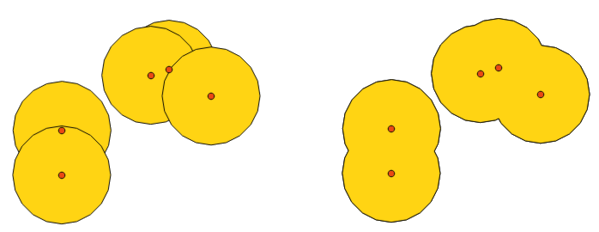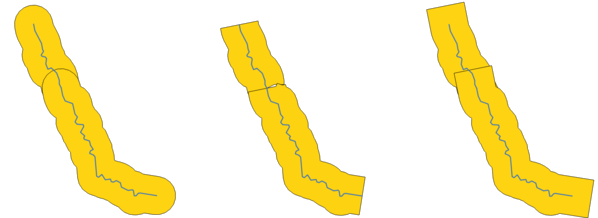25.1.8. Modeler tools
Warnung
These tools are only available in the Graphical Modeler. They are not available in the Processing Toolbox.
25.1.8.1. Conditional branch
Adds a conditional branch into a model, allowing parts of the model to be executed based on the result of an expression evaluation. Mostly by using tool dependencies to control the flow of a model.
Parameter
Label |
Name |
Type |
Beschreibung |
|---|---|---|---|
Field |
|
[string] |
Name of the condition |
Field |
|
[expression] |
Expression to evaluate |
Ausgaben
None.
Python code
Algorithm ID: native:condition
import processing
processing.run("algorithm_id", {parameter_dictionary})
The algorithm id is displayed when you hover over the algorithm in the Processing Toolbox. The parameter dictionary provides the parameter NAMEs and values. See Verarbeitung Algorithmen von der Konsole aus verwenden for details on how to run processing algorithms from the Python console.
25.1.8.2. Create directory
Creates a new directory on a file system. Directories will be created recursively, creating all required parent directories in order to construct the full specified directory path. No errors will be raised if the directory already exists.
Parameter
Label |
Name |
Type |
Beschreibung |
|---|---|---|---|
Directory path |
|
[string] |
Folder path to create |
Ausgaben
Label |
Name |
Type |
Beschreibung |
|---|---|---|---|
Output |
|
[folder] |
Created folder |
Python code
Algorithm ID: native:createdirectory
import processing
processing.run("algorithm_id", {parameter_dictionary})
The algorithm id is displayed when you hover over the algorithm in the Processing Toolbox. The parameter dictionary provides the parameter NAMEs and values. See Verarbeitung Algorithmen von der Konsole aus verwenden for details on how to run processing algorithms from the Python console.
25.1.8.3. Feature filter
Filters features from the input layer and redirects
them to one or several outputs.
If you do not know about any attribute names that are common to all
possible input layers, filtering is only possible on the feature
geometry and general record mechanisms, such as $id and uuid.
Parameter
Label |
Name |
Type |
Beschreibung |
|---|---|---|---|
Input layer |
|
[vector: any] |
The input layer. |
Outputs and filters (one or more) |
|
[same as input] |
The output layers with filters (as many as there are filters). |
Ausgaben
Label |
Name |
Type |
Beschreibung |
|---|---|---|---|
Output (one or more) |
|
[same as input] |
The output layers with filtered features (as many as there are filters). |
Python code
Algorithm ID: native:filter
import processing
processing.run("algorithm_id", {parameter_dictionary})
The algorithm id is displayed when you hover over the algorithm in the Processing Toolbox. The parameter dictionary provides the parameter NAMEs and values. See Verarbeitung Algorithmen von der Konsole aus verwenden for details on how to run processing algorithms from the Python console.
25.1.8.4. Filter by geometry type
Filters features by their geometry type. Incoming features will be directed to different outputs based on whether they have a point, line or polygon geometry.
Parameter
Label |
Name |
Type |
Beschreibung |
|---|---|---|---|
Input layer |
|
[vector: any] |
Layer to evaluate |
Ausgaben
Label |
Name |
Type |
Beschreibung |
|---|---|---|---|
Point features Optional |
|
[vector: point] |
Layer with points |
Line features Optional |
|
[vector: line] |
Layer with lines |
Polygon features Optional |
|
[vector: polygon] |
Layer with polygons |
Features with no geometry Optional |
|
[table] |
Geometry-less vector layer |
Python code
Algorithm ID: native:filterbygeometry
import processing
processing.run("algorithm_id", {parameter_dictionary})
The algorithm id is displayed when you hover over the algorithm in the Processing Toolbox. The parameter dictionary provides the parameter NAMEs and values. See Verarbeitung Algorithmen von der Konsole aus verwenden for details on how to run processing algorithms from the Python console.
25.1.8.5. Filter layers by type
Filters layers by their type. Incoming layers will be directed to different outputs based on whether they are a vector or raster layer.
Parameter
Label |
Name |
Type |
Beschreibung |
|---|---|---|---|
Input layer |
|
[layer] |
Generic Map Layer |
Ausgaben
Label |
Name |
Type |
Beschreibung |
|---|---|---|---|
Vector features Optional |
|
[vector] |
A Vector Layer of the input, if compatible |
Raster layer Optional |
|
[raster] |
A Raster Layer of the input, if compatible |
Python code
Algorithm ID: native:filterlayersbytype
import processing
processing.run("algorithm_id", {parameter_dictionary})
The algorithm id is displayed when you hover over the algorithm in the Processing Toolbox. The parameter dictionary provides the parameter NAMEs and values. See Verarbeitung Algorithmen von der Konsole aus verwenden for details on how to run processing algorithms from the Python console.
25.1.8.6. Load layer into project
Loads a layer to the current project.
Parameter
Label |
Name |
Type |
Beschreibung |
|---|---|---|---|
Layer |
|
[layer] |
Layer to load in the legend |
Loaded layer name |
|
[string] |
Name of the loaded layer |
Ausgaben
Label |
Name |
Type |
Beschreibung |
|---|---|---|---|
Layer |
|
[same as input] |
The (renamed) loaded layer |
Python code
Algorithm ID: native:loadlayer
import processing
processing.run("algorithm_id", {parameter_dictionary})
The algorithm id is displayed when you hover over the algorithm in the Processing Toolbox. The parameter dictionary provides the parameter NAMEs and values. See Verarbeitung Algorithmen von der Konsole aus verwenden for details on how to run processing algorithms from the Python console.
25.1.8.7. Raise exception
Raises an exception and cancels a model’s execution. The exception message can be customized, and optionally an expression based condition can be specified. If an expression condition is used, then the exception will only be raised if the expression result is true. A false result indicates that no exception will be raised, and the model execution can continue uninterrupted.
Parameter
Label |
Name |
Type |
Beschreibung |
|---|---|---|---|
Message |
|
[string] |
Message to display |
Condition Optional |
|
[expression] |
Expression to evaluate if true |
Ausgaben
A message in the log panel.
Python code
Algorithm ID: native:raiseexception
import processing
processing.run("algorithm_id", {parameter_dictionary})
The algorithm id is displayed when you hover over the algorithm in the Processing Toolbox. The parameter dictionary provides the parameter NAMEs and values. See Verarbeitung Algorithmen von der Konsole aus verwenden for details on how to run processing algorithms from the Python console.
25.1.8.8. Raise warning
Raises a warning message in the log. The warning message can be customized, and optionally an expression based condition can be specified. If an expression condition is used, then the warning will only be logged if the expression result is true. A false result indicates that no warning will be logged.
Parameter
Label |
Name |
Type |
Beschreibung |
|---|---|---|---|
Message |
|
[string] |
Message to display |
Condition Optional |
|
[expression] |
Expression to evaluate if true |
Ausgaben
A message in the log panel.
Python code
Algorithm ID: native:raisewarning
import processing
processing.run("algorithm_id", {parameter_dictionary})
The algorithm id is displayed when you hover over the algorithm in the Processing Toolbox. The parameter dictionary provides the parameter NAMEs and values. See Verarbeitung Algorithmen von der Konsole aus verwenden for details on how to run processing algorithms from the Python console.
25.1.8.9. Rename layer
Renames a layer.
Parameter
Label |
Name |
Type |
Beschreibung |
|---|---|---|---|
Layer |
|
[layer] |
Layer to rename |
New name |
|
[string] |
The new name of the layer |
Ausgaben
Label |
Name |
Type |
Beschreibung |
|---|---|---|---|
Layer |
|
[same as input] |
The (renamed) output layer |
Python code
Algorithm ID: native:renamelayer
import processing
processing.run("algorithm_id", {parameter_dictionary})
The algorithm id is displayed when you hover over the algorithm in the Processing Toolbox. The parameter dictionary provides the parameter NAMEs and values. See Verarbeitung Algorithmen von der Konsole aus verwenden for details on how to run processing algorithms from the Python console.
25.1.8.10. Save log to file
Saves the model’s execution log to a file. Optionally, the log can be saved in a HTML formatted version.
Parameter
Label |
Name |
Type |
Beschreibung |
|---|---|---|---|
Use HTML |
|
[Boolean] Default: False |
Use HTML formatting |
Ausgaben
Label |
Name |
Type |
Beschreibung |
|---|---|---|---|
File |
|
[string] |
Destination of the log |
Python code
Algorithm ID: native:savelog
import processing
processing.run("algorithm_id", {parameter_dictionary})
The algorithm id is displayed when you hover over the algorithm in the Processing Toolbox. The parameter dictionary provides the parameter NAMEs and values. See Verarbeitung Algorithmen von der Konsole aus verwenden for details on how to run processing algorithms from the Python console.
25.1.8.11. Set project variable
Sets an expression variable for the current project.
Parameter
Label |
Name |
Type |
Beschreibung |
|---|---|---|---|
Variable name |
|
[string] |
Name of the variable |
Variable value |
|
[string] |
Value to be stored |
Ausgaben
None.
Python code
Algorithm ID: native:setprojectvariable
import processing
processing.run("algorithm_id", {parameter_dictionary})
The algorithm id is displayed when you hover over the algorithm in the Processing Toolbox. The parameter dictionary provides the parameter NAMEs and values. See Verarbeitung Algorithmen von der Konsole aus verwenden for details on how to run processing algorithms from the Python console.
25.1.8.12. String concatenation
Concatenates two strings into a single one in the Processing Modeler.
Parameter
Label |
Name |
Type |
Beschreibung |
|---|---|---|---|
Input 1 |
|
[string] |
First string |
Input 2 |
|
[string] |
Second string |
Ausgaben
Label |
Name |
Type |
Beschreibung |
|---|---|---|---|
Concatenation |
|
[string] |
The concatenated string |
Python code
Algorithm ID: native:stringconcatenation
import processing
processing.run("algorithm_id", {parameter_dictionary})
The algorithm id is displayed when you hover over the algorithm in the Processing Toolbox. The parameter dictionary provides the parameter NAMEs and values. See Verarbeitung Algorithmen von der Konsole aus verwenden for details on how to run processing algorithms from the Python console.
25.1.8.13. Variable distance buffer
Warnung
This algorithm is deprecated and can be removed anytime. Prefer using Buffer algorithm instead.
Computes a buffer area for all the features in an input layer.
The size of the buffer for a given feature is defined by an attribute, so it allows different features to have different buffer sizes.
Siehe auch
Parameter
Label |
Name |
Type |
Beschreibung |
|---|---|---|---|
Input layer |
|
[vector: any] |
Input vector layer |
Distance field |
|
[tablefield: numeric] |
Attribute for the distance radius of the buffer |
Segments |
|
[number] Default: 5 |
Controls the number of line segments to use to approximate a quarter circle when creating rounded offsets. |
Dissolve result |
|
[boolean] Default: False |
Choose to dissolve the final buffer, resulting in a single feature covering all input features. 
Abb. 25.8 Normal and dissolved buffer |
End cap style |
|
[enumeration] Default: Round |
Controls how line endings are handled in the buffer. 
Abb. 25.9 Round, flat and square cap styles |
Join style |
|
[enumeration] Default: Round |
Specifies whether round, miter or beveled joins should be used when offsetting corners in a line. |
Miter limit |
|
[number] Default: 2.0 |
Only applicable for mitered join styles, and controls the maximum distance from the offset curve to use when creating a mitered join. |
Ausgaben
Label |
Name |
Type |
Beschreibung |
|---|---|---|---|
Buffer |
|
[vector: polygon] |
Buffer polygon vector layer. |
Python code
Algorithm ID: qgis:variabledistancebuffer
import processing
processing.run("algorithm_id", {parameter_dictionary})
The algorithm id is displayed when you hover over the algorithm in the Processing Toolbox. The parameter dictionary provides the parameter NAMEs and values. See Verarbeitung Algorithmen von der Konsole aus verwenden for details on how to run processing algorithms from the Python console.